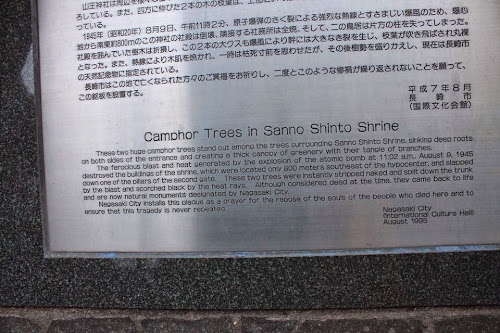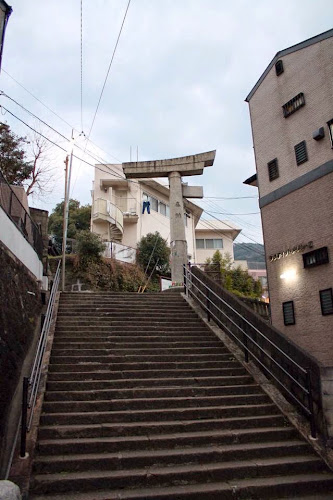Nun wird es bald dunkel, die Sonne ist hinter Wolken und Horizont verschwunden, aber es gibt noch etwas, dass ich sehen muss. Und da Nagasaki eine eher kleine Stadt ist, muss ich auch nicht lange Straßenbahn fahren. Ich kehre nochmals nach Urakami zurück. Dort gibt es den Sannō Schrein, aber es ist nicht der Schrein, den ich besuchen möchte, sondern das Tori. Toris sind die typischen Tore, die den Eingang zu einem Shinto-Schrein markieren, zwei Säulen die einander zustreben, so dass der Abstand oben etwas geringer ist als unten, ein Querbalken und darüber noch einer, etwas größer, leicht geschwungen an den Enden, so das diese in Richtung Himmel streben.Toris gibt es in allen Größen, durch manche kann man gerade so durchtreten, andere, wie zum Beispiel das am Meiji Schrein in Tokyo sind riesig. Oft sind die Toris aus Holz und rot, aber es gibt sie auch aus Stein, und viele kennen Bilder aus Japan, aufgenommen nach Zerstörungen durch Erdbeben, Taifun oder Tzunami, aber auch nach den Bombardierungen im 2. Weltkrieg, wo alles zerstört ist, nur das Tori steht, unverwüstlich, unverrückbar.
Das Tori des Sannō Schreins steht nicht mehr, oder nur noch auf einem Bein. Im Museum und auch schon vorher habe ich Bilder davon gesehen, und nun möchte ich dorthin, als Abschluss meiner Reise.
Auf dem Weg dorthin verlaufe ich ich ein wenig und stehe vor dem Krankenhaus. Achthundert Meter östlich vom Hypocenter. Inzwischen habe ich das Buch von Dr. Nagai Takashi gelesen, in dem er von den ersten Tagen und den Wochen nach der Bombe berichtet, und es ist unglaublich, dass Menschen in so kurzer Distanz zur Explosion überlebt haben, und danach noch arbeitsfähig waren und über viele Tage hinweg unermüdlich den Opfern geholfen haben, ungeachtet dessen, dass alle selber verletzt waren. Besonders fasziniert war ich von der Aussage des Doktors, dass der Elan zu helfen, erst mit der bedingungslosen Kapitulation erlahmte. Hier hatten er und seine Kollegen das Gefühl, es wäre ja doch alles vergebens.
Aber das Krankenhaus war gar nicht mein Ziel, also zurück auf Anfang. Und nun scheine ich auf dem rechten Weg zu sein. Dort ist ein Tori, und somit der Eingang zum Schrein. Die steinernen Laternen stehen hier nicht mehr, sie gehören nun zum Mahnmal am Hypocenter, denn sie sind zwar auf ihren Sockeln verrutscht, aber sie haben den Bombensturm aufrecht überstanden. Der Eingang zum Schrein wird flankiert von zwei riesigen Kampferbäumen, die zwischen 500 und 600 Jahren alt sind. Im Moment der Explosion wurden sie sofort entlaubt, beim rechten Baum der Stamm gespalten. Man ging davon aus, dass die Bäume abgestorben sind. Aber im Frühling 1947 zeigte sich das erste Grün an den verbrannten Stümpfen und heute, nach fast 70 Jahren sind beide Kronen wieder dicht belaubt und bilden ein grünes Dach auf dem Weg zum Schrein. Es gibt eine Leiter an einem der Bäume, und man kann in den Spalt in dem Stamm sehen, in dem noch Scherben, Reste von Ziegeln und Glassplitter zu sehen sind, die durch die Wucht der Explosion umhergeschlendert wurden. In seinem Buch "Die Glocken von Nagasaki" schrieb der Doktor, das er immer die Zikaden hörte in den Kampferbäumen, wenn er im Krankenhaus arbeitete, dass das ein Höllenlärm war, und von der Stille, als sie nicht mehr da waren. Früher wurden die Bäume von den Menschen, die in Nagasaki geblieben waren, umarmt, sie waren das Symbol ihrer Wiederauferstehung, heute gehören sie zum Nationalen Kulturerbe.
Und nun noch ein Stück die Straße entlang, vorbei an einer Landmarke, eine Art Straßenschild, das auf die Urakami Straße hinweist, einst die Hauptstraße in Nagasaki, bis in die Mitte der Edo Zeit. Einst reisten hier die 26 Heiligen von Japan, deren Gedenkstätte sich in der Nähe des Bahnhofs befindet und die die ersten Opfer der Christenverfolgung waren und auch Doktor Kaempfer, Arzt der holländischen Oostindia Campania war hier unterwegs. Später wurde die Nagasaki Straße die Hauptstraße, die vom Hafen in die Berge führt, und sie ist auch heute die am meisten befahrene Straße der Stadt.
Nun geht es nach rechts und das liegen am Wegesrand die Überreste des zweiten Tori des Sannō Schreins und dort steht er, der Einbeinige, wie ihn die Leute hier nennen. Auch hier wieder eine Tafel mit Erläuterungen und historische Fotos, etwas, das mir hier sehr gut gefallen hat. Obwohl ich nach meinem Besuch in der Touristeninformation anfangs den Eindruck hatte, das Nagasaki gar nicht mit Besuchern aus dem Ausland rechnet, fand ich alles Sehenswerte gut ausgeschildert und erklärt.
Und nun bin ich auf dem Rückweg ins Hotel, morgen früh um 6.40 fährt mein Zug zurück nach Hause, also nach Tokyo. Ich blicke mich nochmal um, das zerstörte Tori inmitten eines Wohnviertels, und auf einen Balkon hängt Wäsche zum Trocknen. Da ich im Grunde meines Wesens ein optimistischer Mensch bin, nehme ich das als Zeichen. Wir Menschen sind in der Lage sinnlos grausam, hemmungslos brutal und perfektionistisch in unserer Fähigkeit, alles zu zerstören, zu sein und doch hören wir irgendwann damit auf, erzwungen oder aus freien Stücken, um dann wieder einen Alltag zu leben und gewaschene Wäsche aufzuhängen, um dann festzustellen, dass Leben mit der Wäsche auf dem Balkon uns eigentlich besser gefällt und dass wir dieses behalten wollen. Aber warum immer erst hinterher......
Soon it will be dark, the sun vanished behind clouds and the horizon, but there is still something, I want to see. And because Nagasaki is a small town, I don't have to go that far by street car. I go back again to Urakami, there is Sannō shrine, but it's not the shrine I want to see, it's the tori. Toris are the typical gates, who mark the entrance of a Shinto shrine, two pillars, striving to each other, so there is a bit smaller distance between them up, then down at the ground, one ledger, and a second bigger one, with lightly curves at its ends, so they point skyward. Toris are found in all sizes, some are that tiny, you can't barely walk through and some are gigantic, like those of the Meiji Shrine in Tokyo. Often they are made of wood and painted red, others are made of stones. And we all may know those pictures from Japan, when after a devastation by quake, typhoon or tsunami and after the bombardment in the WWII everything is destroyed but the tori is still standing, everlasting, adamant.
The tori of Sannō shrine isn't standing, or at least only on one leg. I saw pictures in the museum and before I came here, and I wanted to see it, as the final of my journey.
On my way I got lost and found myself in front of the hospital, eight hundred meters East from the hypocenter. Meanwhile I read the book of Doctor Nagai Takashi, where he wrote about the first days and weeks after the atomic bomb, and it's unbelievable that people survived in such a short distance to the hypocenter and have still been able to work after, and take care for all the wounded victims, for so many days, without resting, even if they were injured themselves. The only point, their spirit was broken, was the day of the unconditional surrender, when he and his colleagues had the idea, that everything counts for nothing.
But the hospital was not my goal, so back to the start. And this time it seems to be the right way. There is a tori, that's the entrance to the shrine. The stony lantern aren't here anymore, they belong now to the memorial at the hypocenter, because they survived the bombing blast upright, even if there slipped on their plinths. The entry of the shrine is flanked by two giant camphor trees, 500-600 years old. In the moment of the explosion they were completely defoliant and the trunk of the right one was split. People believed they were dead until in spring 1947 the first green leaves emerged from the coal black stock of the trees, and today, nearly 70 years later the crowns are dense leafy and make a green roof on the way to the shrine. At on of the trees is a ladder and one can see inside the old slit of the trunk pieces of broken dishes, roof tiles and glass, which were hurled around by the power of the blast. In his book "The bells of Nagasaki" wrote the Doctor, that he always heard the cicadas in the huge trees and they made a pandemonium and how silent is was, when they were gone. In former time the trees were hugged by the people, who stood in Nagasaki, they were a symbol of their resurrection, today they are a national cultural heritage.
Now a bit more along the street, passing a landmark, the Urakami road sign. Urakami road was once the main road in Nagasaki until the middle of Edo period. The 26 saints of Japan traveled here, their monument is near the station, they were the first victims of the persecution of Christians and Doctor Kaemper traveled here too, the physician of the Dutch Oostindia Company. Later the Nagasaki road, leading from the port into the mountains, became the main road and is the most busiest street today.
Now a turn to the right and there are laying at the side of the way the remains of the second tori of Sannō shrine and there is standing upright its other part. The One-Legged tori, like people do call it here. And here again a board with explanation and historical photographs, something I really liked here. Even if my first impression, after seeing the tourist information, was, they don't expect any foreigners here, was any place of interest easy to find and very well explained.
Now I'm on my way back to the hotel, tomorrow at 6.40 leaves my train back home, back to Tokyo. And I look back for a last glimpse and there is the destroyed tori in the middle of a living area and behind it someone hung laundry at the balcony for drying. I'm optimistic since I was born and I take it as a sign. We humans are able to be cruel without any sense, brutal without any scruples, able to destroy perfectly and then we will stop it, out of necessity or out of free will and go back to our every day life and hang up laundry, and than we realise, that's the better life, the one with the drying laundry at the balcony, and that we like it more and want to keep it. But why do we only know after.....




















Keine Kommentare:
Kommentar veröffentlichen